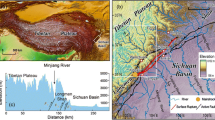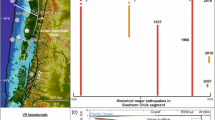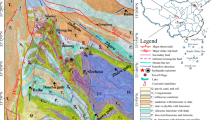Abstract
On 25 August 1933, a 7.5-magnitude earthquake struck the eastern margin of the Tibetan Plateau in Sichuan, China. The Diexi earthquake is among the largest known geohazard events worldwide and is frequently cited by those studying the effects of large earthquakes. And yet, the attention focused on this event has failed to deliver a clear picture of landslides and their geomorphic impacts—key attributes of the Diexi earthquake and its aftermath remain obscure and debated. By integrating present-day LiDAR topographic data with existing records (including studies published in Chinese), and a series of unique archival photographs (from 1910, 1920, and 1934), we present the first inventory of coseismic landslides from the epicentral region of this catastrophic 1933 event. We find that the earthquake-triggered landslides were mainly of shallow to deep rock/debris fall/avalanche type, containing mass detached from steep slopes at the top of the mountain ridge source. We reinterpreted three major landslide dams on the Minjiang River based on their geomorphology and sedimentology, and we reconstructed the processes of impoundment and the maximum area of the dammed lake that breached 45 days after the earthquake. Since 1933, we estimate that 43.15–47.68 million m3 of post-earthquake sediment has been delivered to valley floors from the erosion of the three landslide dams, with a sediment yield of up to 131.71 t km−2 year−1. Retrospective studies of the effects of historical earthquakes are challenging, but long-term observations like these are the cornerstone of emerging knowledge of earthquake-induced landsliding and related landscape response.













Similar content being viewed by others
References
Carey JM, Cosgrove B, Norton K, Massey CL, Petley DN, Lyndsell B (2021) Debris flow-slide initiation mechanisms in fill slopes, Wellington. New Zealand Landslides. https://doi.org/10.1007/s10346-021-01624-6
Chai H, Liu H, Zhang Z (1995) Landslide dams induced by Diexi earthquake in 1933 and its environment effect (in Chinese). Journal of Geological Hazards and Environment Preservation 6(1):7–17
Chang L (1938) Investigation report on Diexi earthquake of Sichuan (in Chinese). Geological Review 3:251–291
Chen L (2014) Stability analysis of Diexi Xiaoaizi dam (in Chinese). China Water Transport 14(12):180–181
Chen S, Wilson C, Deng Q, Zhao X, Luo Z (1994) Active faulting and block movement associated with large earthquakes in the Min Shan and Longmen Mountains, northeastern Tibetan Plateau. J Geophys Res 99(B12). https://doi.org/10.1029/94jb02132
Chen X, Cui P, You Y, Cheng Z, Khan A, Ye C, Zhang S (2017) Dam-break risk analysis of the Attabad landslide dam in Pakistan and emergency countermeasures. Landslides 14:675–683
Chiba, T., Kaneda, S., & Suzuki, Y. (2008). Red Relief Image Map: new visualization method for three dimensional data. In: The International Archives of the Photogrammetry, Remote Sensing and Spatial Information Sciences, pp. 1071–1076 2008 Beijing ISPRS Vol. XXXVII. Part B2.
Croissant T, Steer P, Lague D, Davy P, Jeandet L, Hilton RG (2019) Seismic cycles, earthquakes, landslides and sediment fluxes: linking tectonics to surface processes using a reduced-complexity model. Geomorphology 339:87–103. https://doi.org/10.1016/j.geomorph.2019.04.017
Delchiaro M, Seta MD, Martino S, Dehbozorgi M, Nozaem R (2019) Reconstruction of river valley evolution before and after the emplacement of the giant Seymareh rock avalanche (Zagros Mts., Iran). Earth Surface Dynamics 7:929–947. https://doi.org/10.5194/esurf-7-929-2019
Deng B, Liu S, Liu S, Jansa L, Li Z, Zhong Y (2013) Progressive Indosinian N-S deformation of the Jiaochang structure in the Songpan-Ganzi Fold-Belt, Western China. PLoS One 8(10):e76732. https://doi.org/10.1371/journal.pone.0076732
Domènech G, Fan X, Scaringi G, van Asch TWJ, Xu Q, Huang R, Hales TC (2019) Modelling the role of material depletion, grain coarsening and revegetation in debris flow occurrences after the 2008 Wenchuan earthquake. Eng Geol 250(September 2018):34–44. https://doi.org/10.1016/j.enggeo.2019.01.010
Đomlija P, Gazibara SB, Arbanas Ž, Arbanas SM (2019) Identification and mapping of soil erosion processes using the visual interpretation of Lidar imagery. ISPRS Int J Geo Inf 8(10):1–27. https://doi.org/10.3390/ijgi8100438
Duan Q, Jiang M (2004) Stability analysis of Dahaizi dam induced by Diexi earthquake in Minjiang River (in Chinese). Sichuan Water Power 23(1):93–96
Fan X, Xu Q, Scaringi G, Dai L, Li W, Dong X, Havenith H-B (2017) Failure mechanism and kinematics of the deadly June 24th 2017 Xinmo landslide, Maoxian, Sichuan, China. Landslides 14(6). https://doi.org/10.1007/s10346-017-0907-7
Fan X, Domènech G, Scaringi G, Huang R, Xu Q, Hales TC, Dai L, Yang Q, Francis O (2018a) Spatio-temporal evolution of mass wasting after the 2008 M 7.9 Wenchuan earthquake revealed by a detailed multi-temporal inventory. Landslides 15(12). https://doi.org/10.1007/s10346-018-1054-5
Fan X, Scaringi G, Xu Q, Zhan W, Dai L, Li Y, Huang R (2018b) Coseismic landslides triggered by the 8th August 2017 M 7.0 Jiuzhaigou earthquake (Sichuan, China): factors controlling their spatial distribution and implications for the seismogenic blind fault identification. Landslides 15(5). https://doi.org/10.1007/s10346-018-0960-x
Fan X, Scaringi G, Korup O, West AJ, van Westen CJ, Tanyas H, Hovious N, Hales TC, Jibson RW, Allstadt KE, Zhang L, Evans SE, Xu C, Li G, Pei X, Xu Q, Huang R (2019a) Earthquake-induced chains of geologic hazards: patterns, mechanisms, and impacts. Rev Geophys 57(2):421–503. https://doi.org/10.1029/2018RG000626
Fan, X., Yunus, A. P., Jansen, J. D., Dai, L., Strom, A., & Xu, Q. (2019b). Comment on ‘Gigantic rockslides c Plateau’ by Zhao et al. (2019) Geomorphology 338, 27–42. Geomorphology, (xxxx), 106963. https://doi.org/10.1016/j.geomorph.2019.106963
Fan X, Scaringi G, Domènech G, Yang F, Guo X, Dai L, Huang R (2019c) Two multi-temporal datasets that track the enhanced landsliding after the 2008 Wenchuan earthquake. Earth System Science Data 11(1):35–55. https://doi.org/10.5194/essd-11-35-2019
Fan X, Dufresne A, Siva Subramanian S, Strom A, Hermanns R, Tacconi Stefanelli C, Xu Q (2020) The formation and impact of landslide dams – state of the art. Earth Sci Rev 203(February):103116. https://doi.org/10.1016/j.earscirev.2020.103116
Fan X, Yunus AP, Scaringi G, Catani F, Subramanian SS, Xu Q, Huang R (2021) Rapidly evolving controls of landslides after a strong earthquake and implications for hazard assessments. Geophys Res Lett 48:e2020GL090509. https://doi.org/10.1029/2020GL090509
Flores-Cervantes JH, Istanbulluoglu E, Bras RL (2006) Development of gullies on the landscape: a model of headcut retreat resulting from plunge pool erosion. J Geophys Res Earth Surf 111(1):1–14. https://doi.org/10.1029/2004JF000226
Godard V, Lavé J, Carcaillet J, Cattin R, Bourlès D, Zhu J (2009) Spatial distribution of denudation in Eastern Tibet and regressive erosion of plateau margins. Tectonophysics. https://doi.org/10.1016/j.tecto.2009.10.026
Görüm T (2019) Landslide recognition and mapping in a mixed forest environment from airborne LiDAR data. Eng Geol 258(February):105155. https://doi.org/10.1016/j.enggeo.2019.105155
Guzzetti F, Ardizzone F, Cardinali M, Rossi M, Valigi D (2009) Landslide volumes and landslide mobilization rates in Umbria, central Italy. Earth and Planetary Science Letters 279:222–229. https://doi.org/10.1016/j.epsl.2009.01.005
Hong S (2014) Recent advances of research on Diexi earthquake (in Chinese). Journal of Southwest Jiaotong University 49(2):185–194
Hong S, Xu J (2011) Introduction to photographs about Diexi earthquake retained by geologist Zhou Xiaohe (in Chinese). Seismology and Geology 33(1):225–230
Hong S, Liu S, Xu J, Zhuang W (2011) Interpretation and research on photographs about Diexi earthquake shoot by Zhuang Xueben in 1934 (in Chinese). Seismology and Geology 33(1):208–224
Hong S, Xu J, Wang K (2019) Diexi flood caused by earthquake in 1933: scale, scope, hydrological parameters and subarea characteristics (in Chinese). Earthquake Research in Sichuan 1:5–11
Hovius N, Meunier P, Lin CW, Chen H, Chen YG, Dadson S, Jame H, Lines M (2011) Prolonged seismically induced erosion and the mass balance of a large earthquake. Earth Planet Sci Lett. https://doi.org/10.1016/j.epsl.2011.02.005
Howard AD, Dietrich WE, Seidl MA (1994) Modeling fluvial erosion on regional and continental. J Geophys Res 99(B7):13, 971–113,986 JULY 10, 1994
Howarth JD, Fitzsimons SJ, Norris RJ, Jacobsen GE (2012) Lake sediments record cycles of sediment flux driven by large earthquakes on the Alpine fault, New Zealand. Geology 40(12):1091–1094. https://doi.org/10.1130/G33486.1
Hu X, Hu K, Tang J, You Y, Wu C (2019) Assessment of debris-flow potential dangers in the Jiuzhaigou Valley following the August 8, 2017, Jiuzhaigou earthquake, western China. Eng Geol 256(July 2018):57–66. https://doi.org/10.1016/j.enggeo.2019.05.004
Huang Z, Tang R, Li S (2003) Re-discussion on the Jiaochang Arcuate Structure, Sichuan Province, and the seismogenic structure for Diexi Earthquake in 1933. Earth Research in China 17
Hungr O, Leroueil S, Picarelli L (2014) The Varnes classification of landslide types, an update. Landslides 11(2):167–194. https://doi.org/10.1007/s10346-013-0436-y
Jia K, Zhou S, Wang R (2012) Stress interactions within the strong earthquake sequence from 2001 to 2010 in the Bayankala block of eastern Tibet. Bull Seismol Soc Am 102(5):2157–2164. https://doi.org/10.1785/0120110333
Jiang H, Mao X, Xu H, Yang H, Ma X, Zhong N, Li Y (2014) Provenance and earthquake signature of the last deglacial Xinmocun lacustrine sediments at Diexi, East Tibet. Geomorphology 204:518–531. https://doi.org/10.1016/j.geomorph.2013.08.032
Karakas G, Nefeslioglu HA, Kocaman S, Buyukdemircioglu M, Yurur T, Gokceoglu C (2021) Derivation of earthquake-induced landslide distribution using aerial photogrammetry: the January 24, 2020, Elazig (Turkey) earthquake. Landslides. https://doi.org/10.1007/s10346-021-01660-2
Kargel JS, Leonard GJ, Shugar DH, Haritashya UK, Bevington A, Fielding EJ, Young N (2016) Geomorphic and geologic controls of geohazards induced by Nepal’s 2015 Gorkha earthquake. Science 351(6269). https://doi.org/10.1126/science.aac8353
Keefer DK (1994) The importance of earthquake-induced landslides to long-term slope erosion and slope-failure hazards in seismically active regions. Geomorphology 10(1–4):265–284. https://doi.org/10.1016/0169-555X(94)90021-3
Koi T, Hotta N, Ishigaki I, Matuzaki N, Uchiyama Y, Suzuki M (2008) Prolonged impact of earthquake-induced landslides on sediment yield in a mountain watershed: the Tanzawa region, Japan. Geomorphology 101(4):692–702. https://doi.org/10.1016/j.geomorph.2008.03.007
Korup O (2012) Earth’s portfolio of extreme sediment transport events. Earth Sci Rev 112(2012):115–125. https://doi.org/10.1016/j.earscirev.2012.02.006
Korup O, McSaveney MJ, Davies TRH (2004) Sediment generation and delivery from large historic landslides in the Southern Alps, New Zealand. Geomorphology 61(1–2):189–207. https://doi.org/10.1016/j.geomorph.2004.01.001
Korup O, Densmore AL, Schlunegger F (2010) The role of landslides in mountain range evolution. Geomorphology 120(1–2):77–90. https://doi.org/10.1016/j.geomorph.2009.09.017
Larsen IJ, Montgomery DR, Korup O (2010) Landslide erosion controlled by hillslope material. Nat Geosci 3(4):247–251. https://doi.org/10.1038/ngeo776
Li N, Tang C, Yang T, Chen M (2020) Analysing post-earthquake landslide susceptibility using multi-temporal landslide inventories - a case study in Miansi Town of China. J Mt Sci 17(2):358–372. https://doi.org/10.1007/s11629-019-5681-7
Luo Y, Fan X, Huang R, Wang Y, Yunus AP, Havenith HB (2020) Topographic and near-surface stratigraphic amplification of the seismic response of a mountain slope revealed by field monitoring and numerical simulations. Eng Geol 271(March):105607. https://doi.org/10.1016/j.enggeo.2020.105607
Ma J, Chen J, Cui Z, Zhou W, Liu C, Guo P, Shi Q (2018) Sedimentary evidence of outburst deposits induced by the Diexi paleolandslide-dammed lake of the upper Minjiang River in China. Quat Int 464:460–481. https://doi.org/10.1016/j.quaint.2017.09.022
Marc O, Hovius N (2015) Amalgamation in landslide maps: effects and automatic detection. Nat Hazards Earth Syst Sci 15(4):723–733. https://doi.org/10.5194/nhess-15-723-2015
Parker RN, Densmore AL, Rosser NJ, de Michele M, Li Y, Huang R, Whadcoat S, Petley D (2011) Mass wasting triggered by the 2008 Wenchuan earthquake is greater than orogenic growth. Nat Geosci 4(7):449–452. https://doi.org/10.1038/ngeo1154
Pearce, A.J., & Watson, A.J., (1986), Effects of earthquake-induced landslides on sediment budget and transport over a 50-yr period: Geology, v. 14, p. 52–55, doi:10.1130/0091 -7613 (1986) 14 < 52 :EOELOS>2.0.CO;2.
Peng M, Zhang LM (2012) Breaching parameters of landslide dams. Landslides 9(1):13–31. https://doi.org/10.1007/s10346-011-0271-y
Qian H, Zhou R, Ma S, Li X (2000) South segment of Minjiang Fault and Diexi Earthquake in 1933. Earthquake Research in China 14(2):146–152
Ren J, Xu X, Zhang S, Yeats RS, Chen J, Zhu A, Liu S (2018) Surface rupture of the 1933 M 7.5 Diexi earthquake in eastern Tibet: implications for seismogenic tectonics. Geophys J Int 212(3):1627–1644. https://doi.org/10.1093/gji/ggx498
Rizzitano S, Cascone E, Biondi G (2014) Coupling of topographic and stratigraphic effects on seismic response of slopes through 2D linear and equivalent linear analyses. Soil Dyn Earthq Eng 67:66–84. https://doi.org/10.1016/j.soildyn.2014.09.003
Samia J, Temme A, Bregt A, Wallinga J, Guzzetti F, Ardizzone F, Rossi M (2016) Do landslides follow landslides? Insights in path dependency from a muti-temporal landslide inventory, Landslides 14:547–558. https://doi.org/10.1007/s10346-016-0739-x
Shobe CM, Tucker GE, Anderson RS (2016) Hillslope-derived blocks retard river incision. Geophys Res Lett 43:5070–5078. https://doi.org/10.1002/2016GL069262
Stolle A, Bernhardt A, Schwanghart W, Hoelzmann P, Adhikari BR, Fort M, Kroup O (2017) Catastrophic valley fills record large Himalayan earthquakes, Pokhara, Nepal. Quat Sci Rev 177(2017):88, 103. https://doi.org/10.1016/j.quascirev.2017.10.015
Stolle A, Schwanghart W, Andermann C, Bernhardt A, Fort M, Jansen JD, Wittmann H, Merchel S, Rugel G, Adhikari BJ, Korup O (2018) Protracted river response to medieval earthquakes. Earth Surf Process Landf 44:331–341. https://doi.org/10.1002/esp.4517
Tang R, Fan X, Scaringi G, Xu Q, van Westen CJ, Ren J, Havenith HB (2019) Distinctive controls on the distribution of river-damming and non-damming landslides induced by the 2008 Wenchuan earthquake. Bull Eng Geol Environ 78(6):4075–4093. https://doi.org/10.1007/s10064-018-1381-8
Wang L, Yang L, Wang X, Duan L (2005) Discovery of huge ancient dammed lake on upstream of Minjiang River in Sichuan, China (in Chinese). Journal of Chengdu University of Technology 32(1):1–11
Wang XQ, Li YR, Yuan Y, Zhou Z, Wang LS (2014) Palaeoclimate and palaeoseismic events discovered in Diexi Barrier Lake on the Minjiang River, China. Nat Hazards Earth Syst Sci 14(8):2069–2078. https://doi.org/10.5194/nhess-14-2069-2014
Wang J, Jin Z, Hilton RG, Zhang F, Densmore AL, Li G, Joshua West A (2015) Controls on fluvial evacuation of sediment from earthquake-triggered landslides. Geology 43(2):115–118. https://doi.org/10.1130/G36157.1
Xu C, Xu X (2014) The spatial distribution pattern of landslides triggered by the 20 April 2013 Lushan earthquake of China and its implication to identification of the seismogenic fault. Chin Sci Bull 59(13):1416–1424. https://doi.org/10.1007/s11434-014-0202-0
Xu Q, Zhang S, Li WL, Van Asch TWJ (2012) The 13 August 2010 catastrophic debris flows after the 2008 Wenchuan earthquake, China. Nat Hazards Earth Syst Sci 12(1):201–216. https://doi.org/10.5194/nhess-12-201-2012
Xu C, Xu X, Shen L, Yao Q, Tan X, Kang W, Ma S, Wu X, Cai J, Gao M, Li K (2016) Optimized volume models of earthquake-triggered landslides. Sci Rep 6:29797. https://doi.org/10.1038/srep29797
Yan X, An W, Zhao J, Li Z, Su Z, Xue X (2009) Sidelight of Diexi earthquake relics (in Chinese). Earthquake Research in Shanxi 3:21–31
Zhang S, Zhang LM (2017) Impact of the 2008 Wenchuan earthquake in China on subsequent long-term debris flow activities in the epicentral area. Geomorphology 276:86–103. https://doi.org/10.1016/j.geomorph.2016.10.009
Zhang PZ, Shen Z, Wang M, Gan W, Bürgmann R, Molnar P, Xinzhao Y (2004) Continuous deformation of the Tibetan Plateau from global positioning system data. Geology 32(9):809–812. https://doi.org/10.1130/G20554.1
Zhang S, Zhang L, Lacasse S, Nadim F (2016) Evolution of mass movements near epicentre of Wenchuan Earthquake, the first eight years. Sci Rep 6(October):1–9. https://doi.org/10.1038/srep36154
Zhao S, Chigira M, Wu X (2019) Gigantic rockslides induced by fluvial incision in the Diexi area along the eastern margin of the Tibetan Plateau. Geomorphology 338:27–42. https://doi.org/10.1016/j.geomorph.2019.04.008
Zhu L, Cui S, Pei X, Wang S, He S, Shi X (2021) Experimental investigation on the seismically induced cumulative damage and progressive deformation of the 2017 Xinmo landslide in China. Landslides 18:1485–1498. https://doi.org/10.1007/s10346-020-01608-y
Zhuang J, Cui P, Peng J, Hu K, Iqbal J (2013) Initiation process of debris flows on different slopes due to surface flow and trigger-specific strategies for mitigating post-earthquake in old Beichuan County, China. Environ Earth Sci 68(5):1391–1403. https://doi.org/10.1007/s12665-012-1837-2
Funding
This research is financially supported by the Funds for Creative Research Groups of China (grant no. 41521002), the National Science Fund for Outstanding Young Scholars of China (grant no. 41622206), and National Key R&D Program of China (nos. 2017YFC1501002 and SKLGP2019Z002).
Author information
Authors and Affiliations
Corresponding author
Rights and permissions
About this article
Cite this article
Dai, L., Fan, X., Jansen, J.D. et al. Landslides and fluvial response to landsliding induced by the 1933 Diexi earthquake, Minjiang River, eastern Tibetan Plateau. Landslides 18, 3011–3025 (2021). https://doi.org/10.1007/s10346-021-01717-2
Received:
Accepted:
Published:
Issue Date:
DOI: https://doi.org/10.1007/s10346-021-01717-2




